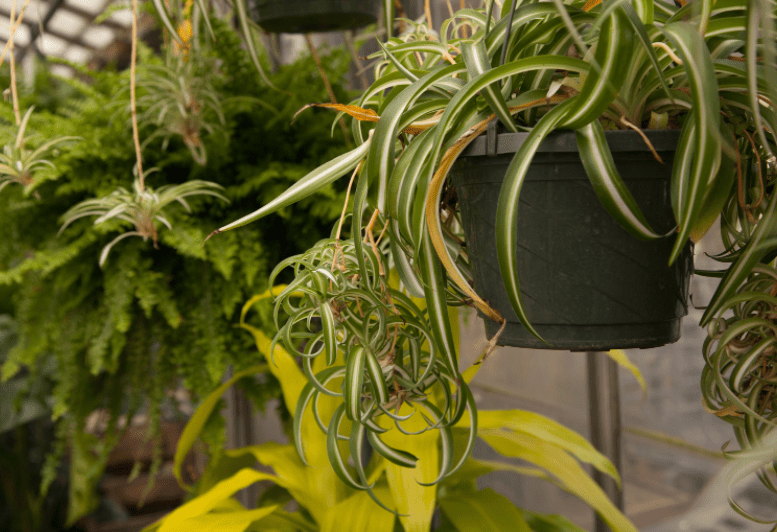Curly Spider Plant
The curly spider plant, Bonnie, more formally known (Chlorophytum comosum), is one of the most popular houseplants. This plant is easy to grow, care for and propagate. The spider plant is a great beginner plant or a fine addition to an already existing indoor garden.
This plant will grow between 15 and 25 cm (6 to 10 inches) in height and spread 25-45 cm (10 to 18 inches).
Another bonus is that the spider plant is one of the plants that NASA has studied to determine their impact on household pollutants such as the off-gassing from carpets. I will explore this air cleaning aspect of houseplants in a future article.
The spider plant’s popularity is easily understood. The plant is ideal for a hanging basket set in the corner, which is well lit, but out of the direct sun. However, the plant can also survive in the shade, but it may not produce the white flowers that enhance its spring and summer beauty.
It proliferates and produces attractive arching leaves. During the spring and summer, the stems, which flow over the container’s sides, produce small white flowers followed by plantlets.
The plantlets can be readily removed from the mother plant and produce new plants.
When it comes to insect attacks, the spider plant has few enemies. Aphids will take advantage of a weak plant due to insufficient light, water, or poor soil. However, keep your plant’s needs met, and pests will not be much of a problem.
If the leaves brown, it is likely that you have not given it enough water, or the air around the plant is excessively hot. Cut off the damaged tips, and all should be well.
Too little light or heat can cause the leaves to go pale and limp, and you may notice some leaf fall. Check your spider plant regularly, and you generally can head off any problems before they do actual harm.
If the leaves are curling and have brown spots, the soil around the roots has likely dried out. The spider plant enjoys a plentiful water supply during its active growing period.
You may find that you want to increase the number of spider plants you have or are interested in giving them as gifts; no problem, the plant is propagated.
The spider plant produces plantlets on the ends of long runners. You can peg a plantlet, which is still attached to the runner of its parent, into a container filled with equal parts moist peat and sharp sand.
Use bent pieces of wire to hold the plantlets in place. Keep them moist, warm, and in medium light until the leaves are 7.5 cm (three inches) long.
You can then cut the plantlets away from the runner with a sharp knife and plant them in their pot.
You now have a great housewarming gift or an inexpensive way to grow your indoor garden.
Frequently Asked Questions
Why do the tips of my curly spider plant have brown spots?
This can happen for a variety of reasons. Extremes in potting mix moisture (either too wet or too dry), salt buildup from fertilizers in the potting mix, and low humidity can all cause it. According to reports, spider plants are also sensitive to fluoride in tap water. To keep the plant tidy, prune the brown tips.
What is causing my curly spider plant to lose its curl?
Surprisingly, if you pay too much attention to your plant, the leaves will be straighter and less curly. A drier potting mix will produce curlier foliage, but don’t go too dry, or you’ll end up with a lot of yellow and brown leaves.
What is the difference between a curly spider plant and a spider plant?
The Curly Spider Plant is smaller with curlier leaves than the regular Spider Plant. The treatment is the same.
Is the Curly Spider Plant dangerous to pets?
Spider plants are not detrimental to dogs, cats, or horses, according to the ASPCA (American Society for the Prevention of Cruelty to Animals). Cats appear to enjoy these plants, but don’t worry; they’re non-toxic!
What are the advantages of cultivating Curly spider plants?
In addition to being easy to grow, Spider plants are one of the best plants for purifying your indoor air and removing many indoor air pollutants, particularly formaldehyde and carbon monoxide.
Why do the leaves on my Curly spider plant develop yellow or brown?
Several factors can lead to yellowing leaves. The most prevalent source of an imbalance is a lack of soil humidity. Yellow leaves can arise if your potting mix turned into totally dry or if it persists extremely wet for an extensive period. Analyze my blog post on the origins of yellow leaves for better in-depth information.


























